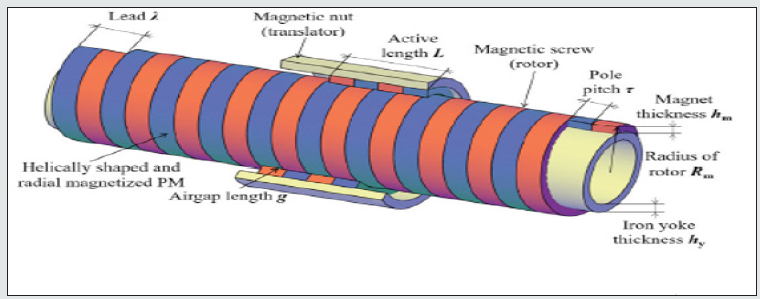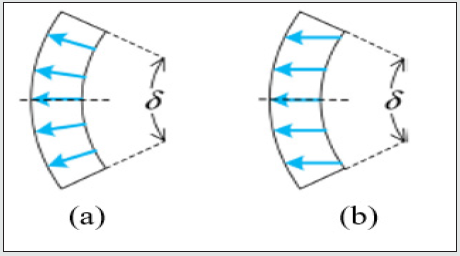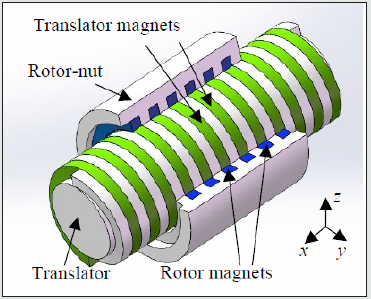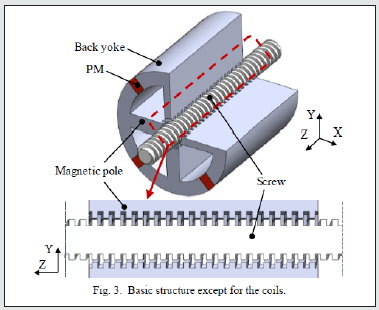
Lupine Publishers Group
Lupine Publishers
Menu
ISSN: 2643-6736
Mini Review Article(ISSN: 2643-6736) 
A mini review on Magnetic Lead Screw Technologies Volume 3 - Issue 1
Uday Kiran K A V and Darius Gnanaraj Solomon*
- *Department of Design and Automation, School of Mechanical Engineering, Vellore Institute of Technology, Vellore, Tamil Nadu, India
Received:June 23, 2021 Published: July 6, 2021
Corresponding author: Darius Gnanaraj Solomon, Department of Design and Automation, School of Mechanical Engineering, Vellore, Tamil Nadu, India
DOI: 10.32474/ARME.2021.03.000154
Abstract
Magnetic lead screw (MLS) is the upcoming alternative technology to conventional lead screw technology in modern engineering. MLSs use the principle of magnetic levitation for achieving the linear motion of the nut by converting the rotary motion of the screw. The advantage of magnetic levitation in the MLSs eliminates the contact between the screw and the nut by resulting in zero contact force, longer life with less operational maintenance and costs. This review presents the advancements in the Magnetic lead screw technologies which elaborate the design parameters, manufacturing procedures, and areas of applications of the MLS.
Introduction
Lead screw has a wide range of applications in the industrial sector ranging from conventional lathe machines, servo motors to wave energy conversion systems. The recent advancements in the lead screw technology for converting the rotary motion to linear motion and vice versa include the development of contactless Magnetic Lead Screw (MLS) technology. The construction of MLS consists of several helically cut permanent magnets (PMs) attached to the outer surface of the screw and the inner surface of the nut. The working principle utilizes the magnetic levitation in between the screw and the nut, such that due to the helical cut of the PMs the rotating motion of the screw results in achieving the lead for the nut as shown in Figure 1. The performance of the screw depends on various design parameters, methodologies, and the alignment of the magnetic field which causes the translatory motion for the nut (moving body).
Design Parameters
The design parameters which influence the performance rate of the MLS are the Rotor Radius, Translatory Radius, Permanent Magnet Width [1], Permanent Magnet Thickness, Air Gap, Force Density, and Pole Pitch (Pitch between two adjacent poles) [2]. The parameter force density defines the ratio between the thrust force on the screw to the total volume of the MLSs permanent magnets and the Rotor radius. It is a significant parameter that affects the air gap between the screw and the nut to maintain optimal magnetic flux for achieving the linear motion. Zhu et.al [3] mentioned a significant increase in thrust force and a decrease in force density which is observed with a change in rotor radius. The thrust force increases with an increase in magnetic thickness and width. Gao et.al showed the the usage of parallelly magnetized permanent magnets results in distortion of air-gap flux density and decrease in average thrust force and torque values, whereas the radially magnetized permanent magnets resulted in smooth air gap flux density and thrust forces [4]. The difference between the parallelly magnetized and radially magnetized magnetic fields is shown in Figure 2.
Few More Designs
Few more designs are shown in Figure 3 where a single helix magnetic lead screw system [5] is proposed for a wave energy converting system and a magnetically levitated lead screw system [6] is proposed to eliminate the number of magnets by using a coil in between the two adjacent magnets.
Conclusion
This review reports the advancements in the Magnetic lead screw technologies by highlighting the design parameters, design methodologies of various types of Magnetic lead screw mechanisms. The Magnetic Lead Screw is more advantageous compared to Conventional lead screw mechanisms for its wide range of applications which utilizes a non-contact type of actuation.
References
- Zhao A, Wu W, Jiang J, Zhu L, Lu K, et.al. (2020) Design and experiment of a magnetic lead screw for the point‐absorbing wave energy conversion system. IET Electric Power Applications 14(11): 2146-2153.
- Tian T, Wu W, Jiang J, Zhu L, Lu K, et.al. (2020) Design Optimization of a Reluctance Lead Screw for Wave Energy Conversion. Energies 13(20): 5388.
- L Zhu, T Tian, J Jiang, W Wu, K Lu, et.al. (2020) A Novel Single-Helix Magnetic Lead Screw for Wave Energy Converter. IECON 2020 The 46th Annual Conference of the IEEE Industrial Electronics Society, Singapore, pp. 2807-2812.
- F Gao, Q Wang, J Zou (2020) Analytical Modeling of 3-D Magnetic Field and Performance in Magnetic Lead Screws Accounting for Magnetization Pattern. IEEE Transactions on Industrial Electronics 67(6): 4785-4796.
- Q Wang, F Gao, J Zhang, Y Li (2020) Analysis and Reduction of Detent Effect in Magnetic Lead Screws with Parallel Magnetized Permanent Magnet Segments. IEEE Access 8: 84177-84187.
- A Heya, Y Nakata, K Hirata, H Ishiguro (2019) A Magnetically Levitated Lead Screw for Complete Non-Contact Power Transmission. IECON 2019 - 45th Annual Conference of the IEEE Industrial Electronics Society, Lisbon, Portugal. pp. 846-849.

Top Editors
-

Mark E Smith
Bio chemistry
University of Texas Medical Branch, USA -

Lawrence A Presley
Department of Criminal Justice
Liberty University, USA -

Thomas W Miller
Department of Psychiatry
University of Kentucky, USA -

Gjumrakch Aliev
Department of Medicine
Gally International Biomedical Research & Consulting LLC, USA -

Christopher Bryant
Department of Urbanisation and Agricultural
Montreal university, USA -

Robert William Frare
Oral & Maxillofacial Pathology
New York University, USA -

Rudolph Modesto Navari
Gastroenterology and Hepatology
University of Alabama, UK -

Andrew Hague
Department of Medicine
Universities of Bradford, UK -

George Gregory Buttigieg
Maltese College of Obstetrics and Gynaecology, Europe -

Chen-Hsiung Yeh
Oncology
Circulogene Theranostics, England -
.png)
Emilio Bucio-Carrillo
Radiation Chemistry
National University of Mexico, USA -
.jpg)
Casey J Grenier
Analytical Chemistry
Wentworth Institute of Technology, USA -
Hany Atalah
Minimally Invasive Surgery
Mercer University school of Medicine, USA -

Abu-Hussein Muhamad
Pediatric Dentistry
University of Athens , Greece

The annual scholar awards from Lupine Publishers honor a selected number Read More...









